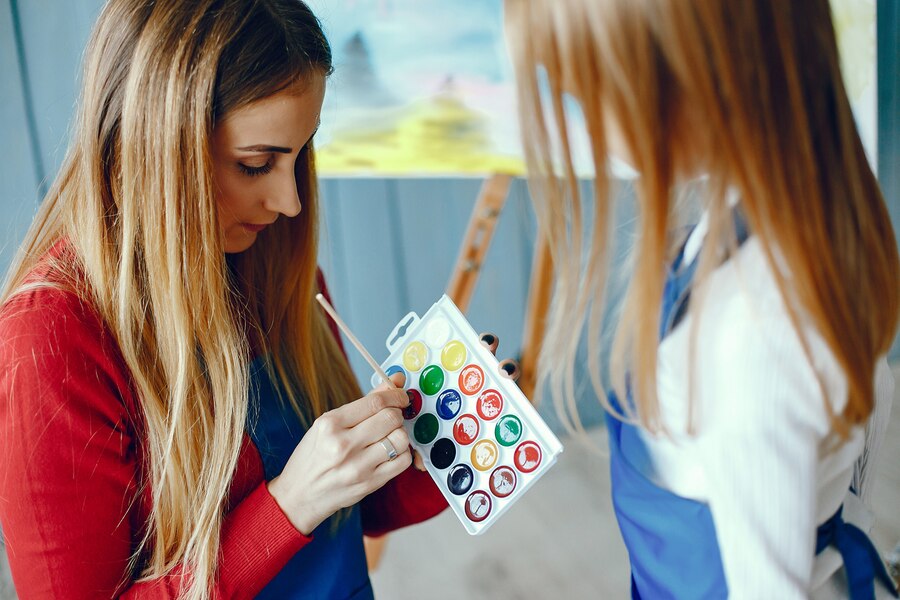
Color theory is an essential concept for artists, designers, and anyone involved in visual creativity. It is the foundation upon which all great artwork is built, providing a framework for understanding how colors interact, complement, and contrast with one another. By mastering color theory, you can elevate your artwork, evoke specific emotions, and create visually harmonious compositions. Whether you’re a beginner or a seasoned artist, understanding the principles of color theory can significantly enhance your creative process. In this comprehensive guide, we’ll explore the fundamentals of color theory, its practical applications, and how you can use it to create stunning artwork.
The Basics of Color Theory
At its core, color theory is the study of how colors work together and how they affect human perception. It is based on the color wheel, a visual representation of colors arranged according to their chromatic relationship. The color wheel was first conceptualized by Sir Isaac Newton in the 17th century and has since evolved into a vital tool for artists and designers. The traditional color wheel consists of 12 colors: three primary colors (red, blue, and yellow), three secondary colors (green, orange, and purple), and six tertiary colors (created by mixing primary and secondary colors). Understanding the color wheel is the first step in mastering color theory, as it helps you identify complementary, analogous, and triadic color schemes. For a deeper dive into the history and science of the color wheel, check out this comprehensive guide by Color Matters.
Primary, Secondary, and Tertiary Colors
The primary colors—red, blue, and yellow—are the building blocks of all other colors. They cannot be created by mixing other colors and are used to create secondary and tertiary colors. Secondary colors are formed by mixing two primary colors in equal proportions. For example, red and blue create purple, blue and yellow create green, and red and yellow create orange. Tertiary colors, on the other hand, are created by mixing a primary color with a neighboring secondary color. Examples include red-orange, blue-green, and yellow-green. These colors add depth and complexity to your artwork, allowing you to create more nuanced and dynamic compositions. To explore more about primary, secondary, and tertiary colors, visit Canva’s Color Wheel Guide.
The Psychology of Color
Colors have a profound impact on human emotions and behavior, making the psychology of color a crucial aspect of color theory. Different colors evoke different feelings and associations, which can be leveraged to enhance the emotional impact of your artwork. For example, warm colors like red, orange, and yellow are often associated with energy, passion, and happiness, while cool colors like blue, green, and purple evoke calmness, tranquility, and sophistication. Understanding the psychological effects of color can help you create artwork that resonates with your audience on a deeper level. For a detailed exploration of color psychology, check out this article by Verywell Mind.
Color Harmony and Schemes
Color harmony refers to the aesthetically pleasing arrangement of colors in a composition. It is achieved by using color schemes, which are predefined combinations of colors based on their positions on the color wheel. Some of the most common color schemes include complementary, analogous, triadic, and monochromatic. Complementary colors are opposite each other on the color wheel, such as red and green or blue and orange. They create high contrast and vibrant effects, making them ideal for creating focal points in your artwork. Analogous colors are next to each other on the color wheel, such as blue, blue-green, and green. They create harmonious and cohesive compositions, perfect for conveying a sense of unity. Triadic color schemes involve three colors evenly spaced around the color wheel, such as red, yellow, and blue. They offer a balanced and dynamic look, while monochromatic schemes use variations of a single color to create a subtle and elegant effect. To learn more about color harmony and schemes, visit Adobe’s Color Theory Guide.
The Role of Value and Saturation
Value and saturation are two critical aspects of color theory that influence the overall mood and impact of your artwork. Value refers to the lightness or darkness of a color, while saturation refers to its intensity or purity. By adjusting the value and saturation of colors, you can create depth, contrast, and emphasis in your compositions. For example, using high-value colors (light colors) can create a sense of airiness and openness, while low-value colors (dark colors) can add drama and intensity. Similarly, highly saturated colors can grab attention and create a bold statement, while desaturated colors can evoke a sense of calm and subtlety. Understanding how to manipulate value and saturation allows you to create more dynamic and visually engaging artwork. For a deeper understanding of value and saturation, explore this guide by Draw Paint Academy.
Practical Applications of Color Theory in Art
Color theory is not just an abstract concept; it has practical applications in various forms of art, including painting, digital art, graphic design, and photography. In painting, understanding color theory can help you mix colors accurately and create realistic or expressive effects. For digital artists, color theory is essential for creating visually appealing designs and user interfaces. In photography, color theory can guide your use of lighting, filters, and post-processing techniques to enhance the mood and impact of your images. By applying the principles of color theory, you can elevate your artwork and communicate your artistic vision more effectively. For practical tips on using color theory in different art forms, check out this article by Creative Bloq.
Color Theory in Digital Art and Design
In the digital age, color theory has become even more relevant, especially in fields like web design, branding, and digital illustration. Digital artists and designers rely on color theory to create visually appealing and user-friendly designs. For example, in web design, color theory is used to create color palettes that enhance readability, navigation, and user experience. In branding, colors are carefully chosen to reflect a company’s identity and values, influencing how consumers perceive the brand. Digital illustrators use color theory to create vibrant and cohesive compositions, often experimenting with different color schemes and effects. To explore how color theory is applied in digital art and design, visit Smashing Magazine’s Guide to Color Theory.
Common Mistakes to Avoid in Color Theory
While color theory is a powerful tool, it’s easy to make mistakes if you’re not careful. One common mistake is using too many colors, which can create a chaotic and overwhelming composition. Another mistake is neglecting the importance of value and saturation, resulting in flat and uninteresting artwork. Additionally, relying solely on complementary colors without considering other color schemes can limit your creative possibilities. To avoid these pitfalls, it’s essential to practice and experiment with different color combinations, paying attention to how they interact and affect the overall composition. For more tips on avoiding common color theory mistakes, read this article by Art Ignition.
Tools and Resources for Mastering Color Theory
Fortunately, there are numerous tools and resources available to help you master color theory. Online color wheels, such as the one provided by Coolors, allow you to experiment with different color schemes and generate harmonious palettes. Design software like Adobe Photoshop and Illustrator also includes color tools that make it easy to apply color theory principles to your work. Additionally, there are countless books, courses, and tutorials available for those who want to deepen their understanding of color theory. Some recommended resources include “Interaction of Color” by Josef Albers and “Color and Light: A Guide for the Realist Painter” by James Gurney. For a curated list of color theory resources, visit Design School’s Guide.
Conclusion: Elevate Your Artwork with Color Theory
Understanding color theory is a game-changer for any artist or designer. It provides the tools and knowledge needed to create visually stunning and emotionally impactful artwork. By mastering the basics of the color wheel, exploring the psychology of color, and experimenting with different color schemes, you can take your creative work to the next level. Whether you’re a painter, digital artist, or photographer, color theory is an invaluable skill that will enhance your ability to communicate and connect with your audience. So, dive into the world of color theory, experiment with different techniques, and watch as your artwork transforms into something truly extraordinary. For further inspiration and guidance, explore the wealth of resources available online, such as Tate’s Guide to Color Theory and Artsy’s Color Theory Overview. Happy creating!
